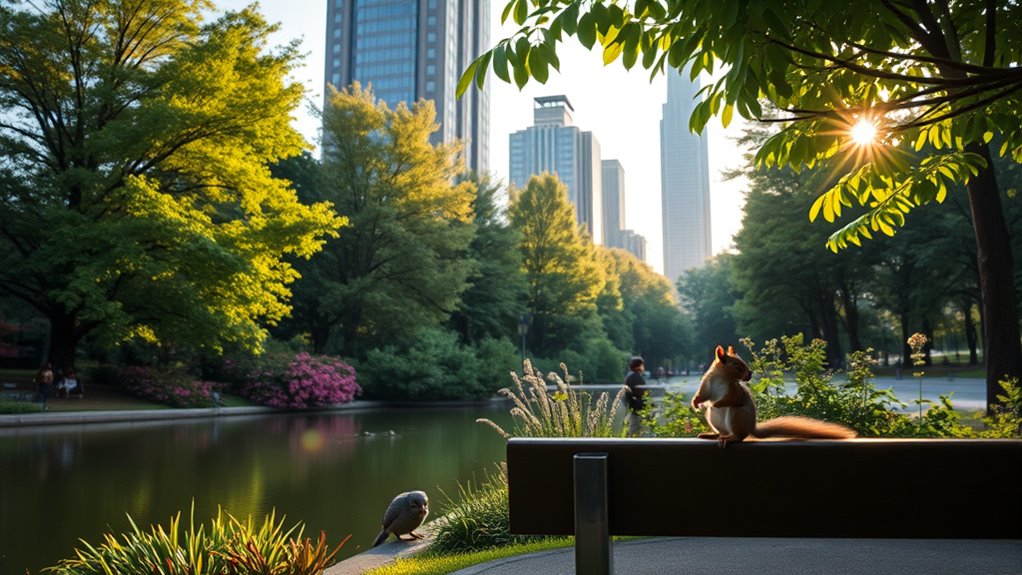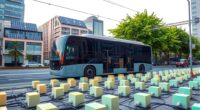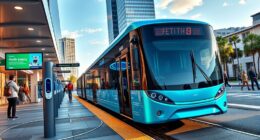By incorporating green spaces and native plantings, you help boost biodiversity in urban areas. These plants absorb carbon dioxide, improve air quality, and lower emissions, making cities cleaner and healthier. They also buffer noise from traffic and construction, creating quieter environments for wildlife. This benefits both animals and residents by reducing stress and supporting ecosystems. Keep exploring to discover how expanding green spaces can further enhance urban resilience and harmony.
Key Takeaways
- Urban green spaces and native plants absorb pollutants, reducing emissions and improving air quality for wildlife.
- Trees and vegetation mitigate the urban heat island effect, lowering energy use and greenhouse gas emissions.
- Green areas buffer noise pollution from traffic and construction, creating quieter habitats for urban wildlife.
- Biodiverse habitats support pollinators and small animals, enhancing ecosystem resilience and natural regulation.
- Increased greenery promotes healthier environments, decreasing reliance on chemical pollutants and fostering sustainable urban ecosystems.

Have you ever wondered how biodiversity directly benefits your daily life? One of the most noticeable ways is through the creation and preservation of urban green spaces. When cities incorporate parks, community gardens, and tree-lined streets, they’re not just making the city prettier—they’re fostering essential habitats for wildlife and improving your quality of life. These green spaces serve as refuges for birds, insects, and small mammals, helping to sustain local ecosystems amid urban development. By planting native species, you support the natural balance of these environments, offering food and shelter that native insects and birds have relied on for generations. Native plantings are particularly effective because they’re adapted to the local climate and soil, requiring less water and maintenance while providing maximum benefits for wildlife. When you walk through a park with native plantings, you’re witnessing how biodiversity enhances the resilience of city ecosystems. These plants attract pollinators like bees and butterflies, which are indispensable for maintaining healthy plant populations, including those in your local community gardens. The more native species you see around you, the better the environment can regulate itself, reducing the need for chemical interventions and energy-intensive maintenance. Additionally, supporting urban biodiversity can contribute to a healthier environment overall. Urban green spaces filled with native plantings also help lower emissions. Trees and plants absorb carbon dioxide, acting as natural air filters that improve air quality. They mitigate the heat island effect common in cities, reducing the need for air conditioning and cutting down greenhouse gas emissions. As you spend time in these green spaces, you might notice how they help keep the air cooler and fresher, making your outdoor experiences more enjoyable and healthier. Furthermore, these areas act as buffers, absorbing noise pollution from traffic and construction, which benefits both humans and wildlife. Less noise means less stress for city-dwelling animals, allowing them to thrive and carry out essential behaviors like feeding and breeding. This, in turn, can lead to a more balanced and resilient urban ecosystem. When you support efforts to expand green spaces and native plantings in your community, you directly contribute to reducing emissions and noise pollution. Your choices help create a more sustainable environment, where biodiversity isn’t just preserved but actively enhances urban living. It’s clear that fostering biodiversity through thoughtful urban planning isn’t just good for wildlife—it’s an indispensable part of making cities healthier, quieter, and more resilient for everyone.
Frequently Asked Questions
How Does Biodiversity Influence Urban Air Quality?
You can see that biodiversity improves urban air quality by enhancing pollution absorption and air filtration. When diverse plant and animal species thrive, they act like natural filters, capturing pollutants and reducing airborne toxins. This helps clear the air, making urban environments healthier for everyone. So, supporting biodiversity not only benefits wildlife but also directly contributes to cleaner, safer air for your community.
Can Increased Biodiversity Reduce Urban Heat Islands Effectively?
Yes, increasing biodiversity can effectively reduce urban heat islands. You can do this by expanding urban green spaces and planting native species, which provide shade and promote evapotranspiration. Native plantings are especially beneficial because they adapt well to local conditions, requiring less water and maintenance. These strategies help cool the city, improve air quality, and support local wildlife, making urban areas more comfortable and sustainable.
What Specific Species Benefit Most From Urban Biodiversity Initiatives?
Imagine a city alive with buzzing pollinators and chirping birdlife—that’s where the greatest benefits lie. You’ll find native pollinators like bees and butterflies thrive, boosting plant reproduction and food sources. Urban birdlife, including pigeons, sparrows, and songbirds, also flourish in greener spaces. These species benefit most from biodiversity initiatives because they rely on diverse habitats and native plants, which help sustain their populations amidst city life.
How Quickly Can Urban Biodiversity Improvements Impact Local Climate?
You can see urban biodiversity improvements impact your local climate within a few years. Urban greenery, like trees and green roofs, helps reduce heat and improves climate resilience by providing shade and cooling effects. As plants thrive, they filter air pollutants and lower emissions, making your city cooler and healthier. Active efforts in expanding green spaces rapidly enhance climate benefits, making urban areas more resilient against climate change impacts.
Are There Any Disadvantages to Increasing Biodiversity in Cities?
Yes, increasing biodiversity in cities can have disadvantages. Urban planning challenges may arise, requiring significant resources and careful design to avoid issues like overgrowth or invasive species. Community engagement is essential but can be difficult if residents resist changes or lack awareness. You might also face maintenance costs or unintended impacts on local infrastructure. Balancing ecological benefits with practical considerations is key to ensuring successful biodiversity initiatives.
Conclusion
So, by boosting urban biodiversity, you’ll open a world where emissions vanish faster than a sneeze and noise levels drop to near silence—turning your city into a peaceful sanctuary for wildlife. Imagine living in a place so serene, even the busiest streets feel like quiet retreats. It’s not just an upgrade; it’s a complete transformation of your urban jungle into an oasis of calm and clean air. Embrace biodiversity, and watch your city become the ultimate wildlife paradise!









